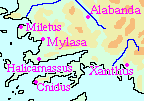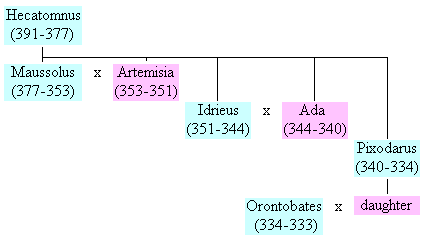Hecatomnid dynasty
Q18206388
For about a century and half, Caria (the southwest of what is now called Turkey) had been part of the Achaemenid Empire, and was ruled by satraps. The country appears to have been able to retain some of its independence, especially in the first half of the fourth century, when it was ruled by satraps of Carian descent, the Hecatomnids.
The main reason for the comparative independence of this dynasty was that Caria bordered on the country of the military strong Greeks, who were politically divided and always willing to serve as mercenaries. Because in these years, the Achaemenid king Artaxerxes II Mnemon was involved in wars against the Cadusians and the Egyptians, the Hecatomnids were able to improve their position. Carians were appointed in office and in their foreign policy, the rulers of Caria acted as if they were independent kings. When king Artaxerxes III Ochus had reorganized Egypt, the days of the Hecatomnids were counted.
The dynasty is called after Hecatomnus of Mylasa (391-377), who was not only satrap of Caria, but also controlled Miletus. He seems to have been fascinated by Greek culture, but was loyal to the Persian king Artaxerxes II, and -from a religious point of view- always remained a Carian.
He was succeeded by his son Maussolus. When he became sole ruler, the Achaemenid empire suffered from the Cadusian war and the conflict with Egypt, but Maussolus remained loyal. For instance, he fought for the great king against Ariobarzanes, a rebel satrap in the northwest of modern Turkey (365). But almost immediately after this war, he took part in the Revolt of the Satraps: Maussolus, Orontes of Armenia, Autophradates of Lydia and Datames of northern Turkey joined forces against their king, with support of the pharaohs of Egypt, Nectanebo I, Teos, and Nectanebo II. Although they were defeated, king Artaxerxes III Ochus had to reinstall Maussolus as satrap of Caria. However, he was controlled by a Persian garrison in his newly founded capital Halicarnassus.
One of the most remarkable aspects of Maussolus' reign is his strict adherence to the ancient cults of Caria. Although it was not unusual for the dynasts of what is now Turkey to sacrifice to the Persian supreme god Ahuramazda, or to venerate the Greek gods, none of these religious beliefs can be attested for Maussolus.
In 357, he helped the allies of Athens, who had revolted against their overlord. Some of them - Chios, Kos, Rhodes, and Byzantium - now became federates of Maussolus. This was his usual policy: he ruled Caria, had allies abroad, and left the towns in his territory more or less autonomous. This model was copied by later rulers.
Maussolus died in 353 and was succeeded by his sister (and wife) Artemisia, who was able to retain the comparative independence of Caria. She is best known for building a sepulchral monument for her dead husband, the Mausoleum, which was considered to be one of the seven wonders of the ancient world.
After the brief reign of Artemisia, Maussolus' brother Idrieus was satrap, and he was succeeded in 344 by his quarreling brother Pixodarus and sister Ada. This happened at more or less the same time as the conquest of Egypt by Artaxerxes III Ochus, which meant that the Achaemenid king had his hands free to put an end to the autonomy of Caria. Pixodarus tried to ally himself to king Philip II of Macedonia, but in vain, and a Persian commander named Orontobates is known to have been in charge of the satrapy in the mid-330s.
When Philip's son Alexander invaded the Achaemenid empire and approached Caria in 334, he allied himself to Ada, who was recognized as satrap. She appears to have died in 326.
| Hecatomnus | 391-377 |
| Maussolus | 377-353 |
| Artemisia | 353-351 |
| Idrieus | 351-344 |
| Ada (first reign) | 344-340 |
| Pixodarus | 340-334 |
| Ada (second reign) | 334-326? |
